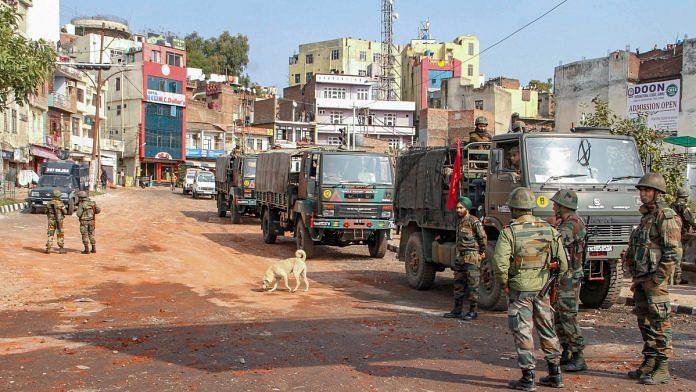New Delhi: A convoy of 78 vehicles was carrying just over 2,500 CRPF personnel down the 300-km Jammu-Srinagar National Highway-1 when a suicide bomber struck last Thursday, killing at least 40 troopers and reducing their bus to a mangled heap.
Among the many questions that arose in the wake of the attack was how the convoy came under attack, and why security personnel were not airlifted across the restive state, instead of being transported by roads in convoys vulnerable to terrorist ambushes.
ThePrint dives in.
What happened on 14 February
A convoy is a cluster of vehicles moving together.
The CRPF convoy attacked Thursday was travelling from Jammu to Srinagar when it was attacked near Lethpora, just short of 30 km from the summer capital, in Pulwama.
It was an unusually large convoy because the highway had just reopened after a snow-triggered shutdown.
It was en route to different camps across the Valley, including south Kashmir, which has emerged as the hotbed of homegrown terrorism in the wake of Hizbul Mujahideen commander Burhan Wani’s death in 2016.
The south Kashmir belt of the highway, a 55.9-km stretch, starts at Qazigund and ends at Pampore, just over an hour away from Srinagar.
The distance between Jammu and Srinagar through NH-1 is covered in approximately 10 hours, which is why security convoys from Jammu generally depart in the small hours of the morning so they can reach the Valley before nightfall.
The CRPF convoy attacked broke first at Qazigund, where 14 vehicles stopped while 78 others moved on.
Also read: The IED twist to Kashmir terrorism — ‘worst fears’ of security forces have come true
Convoys and SOP
All the security forces have a Standard Operating Procedure (SOP) that dictates the movement of convoys, rules that are reviewed from time to time.
“The Standard Operating Procedure of convoy movement deals with physical and proximate security of the forces,” a source in the security forces told ThePrint.
“The Army has its own, as do other security forces, [like] the Central Armed Police Forces (CRPF, BSF, SSB, ITBP and CISF) and state police. The essence of the SOP is that each convoy will have adequate security or an escort party,” the source added.
Each stretch of road a security convoy is expected to pass through is first subjected to mandatory anti-sabotage checks by the road opening party and an advance party of the convoy.
CRPF deputy inspector general Moses Dinakaran said the road opening party checked and sanitised the area within a 50-km radius.
According to Dinakaran, each convoy includes a security detail of 20 vehicles, including a pilot and bullet-proof vehicles. “A convoy commander, along with an inspector and a sub-inspector, accompanies them,” he added.
“The convoy is meant to coordinate between vehicles — check speed and distance between various vehicles,” said the security source quoted above. “Unscheduled halts are to be avoided. The movement control units, traffic check posts are to maintain strict discipline on the movement of vehicles,” the source added.
What makes convoys vulnerable to attacks?
In the 14 February attack, the suicide bomber is said to have parked his vehicle “two kilometres from the highway in a village”, from where he is believed to have sped forward and rammed into the convoy when it arrived.
There are apprehensions that the movement of civilian vehicles when military convoys are in progress could have been among the reasons for the breach of security.
Following the 2003 ceasefire with Pakistan along the Line of Control, the Indian Army had relaxed the rules for civilian traffic during the movement of security convoys. This was done on the request of then Jammu & Kashmir chief minister Mufti Mohammad Sayeed.
“It was a political decision, part of the ‘healing touch’ policy,” Waheed-ur-Rehman Parra, the youth president of Sayeed’s Peoples Democratic Party (PDP), told ThePrint.
As a result, a day after last week’s attack, Union Home Minister Rajnath Singh announced restrictions on civilian vehicles on highways and major roads during the movement of convoys of security forces.
Is airlifting security personnel an option?
Experts say airlifting the thousands of security personnel deployed in J&K is unfeasible.
“Airlifting is logistically not a complete solution because a bulk of material is sent with convoys too,” CRPF DIG Dinakaran told ThePrint. “There is one Air India flight that goes [from Jammu to Srinagar] every day. It has 188 seats, and also caters to the BSF, the ITBP and other central armed forces. Also, the weather conditions are not conducive to the option,” he added.
“Every day, we have 300-400 CRPF personnel reaching Jammu after their vacations,” he said
There are around 60 battalions (each battalion has 1,000 men) of CRPF alone in the Valley. “During the Amarnath yatra, 200 companies (each has 100 members) are sent from Jammu to Srinagar, which means 20,000 personnel. The numbers are also high during elections,” he added.
Also read: Indian Army soldiers along the LoC to get deadly sniper rifles this month



